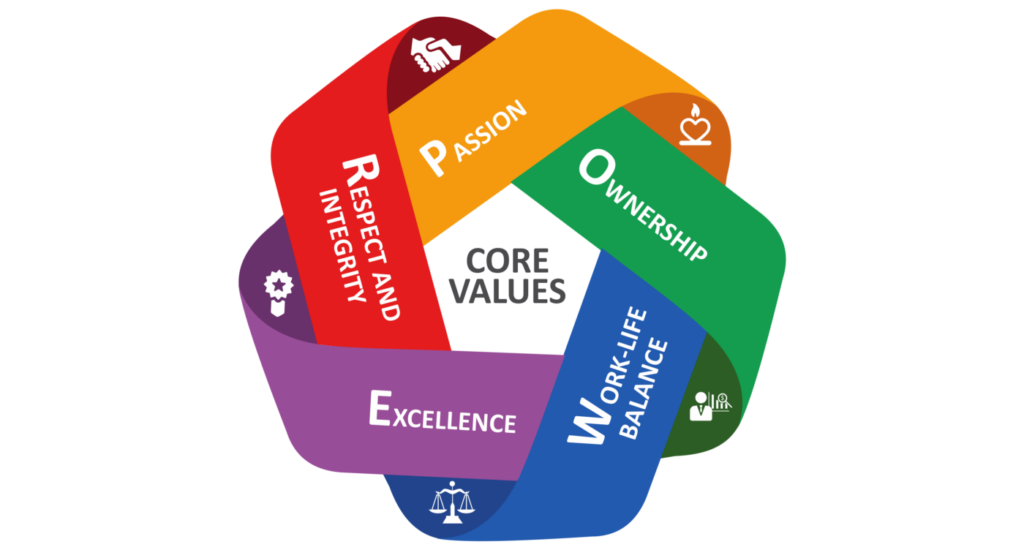The evolving landscape of work has ushered in a new era where remote and hybrid teams have become the norm. Businesses are adapting to this paradigm shift, and maintaining a strong company culture is paramount. In this article, we’ll explore best practices for cultivating company culture in remote and hybrid teams to thrive in the digital age.
1. Embrace Technology for Seamless Collaboration
Strategic incorporation of technology is not merely discretionary but imperative for the cultivation of effective collaboration. The digital era necessitates a paradigm shift towards innovative solutions that empower teams to interact and collaborate seamlessly, irrespective of geographical constraints. To realize this objective, enterprises should prioritize the implementation of robust communication and collaboration tools that serve as the foundation of their virtual workspace.

Businesses are advised to judiciously evaluate and select communication tools that align with their unique workflow. Whether opting for messaging platforms such as Slack, comprehensive collaboration suites like Microsoft Teams, or dedicated video conferencing tools such as Zoom, the emphasis should be on choosing tools that enhance rather than complicate operational processes. Concurrently, a structured approach to training sessions is recommended to familiarize team members with the selected tools. Establishing a robust support mechanism to promptly address any technical issues is equally pivotal in minimizing disruptions to workflow.
The significance of embracing technology lies in its capacity to streamline workflows.. Beyond mere operational efficiency, advanced collaboration tools foster a palpable sense of connectivity among team members, overcoming the inherent limitations of physical separation and enhancing overall team cohesion. Moreover, the infusion of technology engenders an environment conducive to innovative problem-solving and creative collaboration.. Adhering to a strategic and technology-driven approach, businesses position themselves to not only address the challenges of remote work but also to elevate collaboration, thereby fortifying their foundation for sustained success in the digital-first era.
2. Prioritize Transparent and Inclusive Communication
In remote and hybrid team dynamics, transparent and inclusive communication emerges as the linchpin for fostering cohesion and collaboration. The essence lies not merely in conveying information but in establishing an environment where every team member feels valued, informed, and included.
To actualize this, creating and maintaining regular channels for updates becomes imperative. These channels serve as the conduits through which vital information flows seamlessly, creating a shared understanding of the organization’s goals, progress, and challenges. Establishing a routine of town hall meetings, whether virtual or hybrid, amplifies this commitment to transparency. These gatherings transcend traditional hierarchical structures, providing a platform for leadership to communicate directly with the entire team.
Encouraging open dialogue within these forums becomes a catalyst for inclusive communication. Actively seeking input from all team members, regardless of their role or location, fosters a sense of belonging and significance. Inclusivity in communication goes beyond disseminating information; it involves creating spaces where diverse perspectives are not only acknowledged but actively solicited.
Prioritizing transparent and inclusive communication is not just a matter of relaying information; it’s a strategic investment in creating a workplace culture where every voice is heard, valued, and integral to the collective success of the team.
3. Define and Reinforce Core Values
In the dynamic landscape of remote and hybrid work, the articulation and steadfast reinforcement of core values stand as pillars for cultivating a resilient and purpose-driven organizational culture. Core values are not just statements on a wall but guiding principles that anchor the actions, decisions, and interactions of every team member. Their resonance is particularly pronounced in a dispersed work environment where a unified sense of purpose becomes paramount.

To embark on this journey, it’s imperative to clearly articulate core values that align seamlessly with the company’s overarching mission. These values should be more than mere ideals; they should reflect the essence of the organization’s identity and its commitment to excellence, integrity, collaboration, or any other principles deemed foundational. Once defined, these values should be integrated into the fabric of everyday work life, becoming an integral part of the organizational DNA.
Recognition becomes a powerful tool in reinforcing these values. Actively acknowledging and celebrating employees who embody these core values in their actions and contributions creates a positive work culture.
Defining and reinforcing core values is not a static exercise but an ongoing commitment to instilling a sense of purpose and identity within the organization. By aligning these values with everyday work practices and recognizing those who embody them, a company not only fortifies its cultural foundation but also ensures that these principles serve as beacons guiding the collective journey of its dispersed team.
4. Foster Virtual Team Building Activities
Building and sustaining camaraderie goes beyond traditional office interactions. The challenge lies in creating an environment where team members can forge meaningful connections and cultivate a sense of unity despite physical distances. The solution lies in the deliberate organization of virtual team-building activities.
The first step in fostering team camaraderie is to acknowledge the importance of personal connections in a professional setting. Recognizing that shared experiences and personal bonds contribute to a more cohesive team, organizations need to proactively facilitate opportunities. This is where virtual team-building activities play a pivotal role.
Regularity is key in organizing these activities. Consistently scheduling virtual team-building sessions creates an ongoing platform for team members to connect beyond the scope of work-related discussions. Whether it’s weekly, bi-weekly, or monthly, the frequency ensures that these engagements become ingrained in the team’s routine, fostering a sustained sense of camaraderie.
The activities themselves should be diverse and inclusive, catering to varied interests and preferences. Virtual game nights, as exemplified in the case study, offer a lighthearted and enjoyable avenue for team members to unwind and connect. Additionally, team challenges that require collaboration and problem-solving contribute to a positive work culture by emphasizing the importance of teamwork.
Fostering virtual team-building activities is not merely a recreational pursuit but a strategic investment in team dynamics. These activities contribute to elevated morale, a strengthened sense of belonging, and a positive work culture that acknowledges the importance of personal connections in achieving collective professional success.
5. Support Employee Well-being and Work-Life Balance
Acknowledging and addressing the multifaceted challenges that can impact employee well-being is paramount to fostering a healthy and sustainable work culture. The inherent nature of remote work can blur the boundaries between personal and professional life, making it crucial for organizations to proactively support their employees’ well-being.

Recognizing the challenges associated with remote work, organizations must take a holistic approach to employee well-being. This involves not only acknowledging the impact of work-related stressors but actively providing resources and initiatives that support mental health such as encouraging breaks and downtime during the workday. This not only allows employees to recharge but also underscores the organization’s commitment to a balanced and sustainable work-life.
A cornerstone in supporting employee well-being is the provision of resources for mental health such as virtual counseling services, mental health workshops, or access to mental health professionals. By normalizing conversations around mental health and providing tangible resources, organizations create an environment where employees feel supported and valued beyond their professional contributions.
Implementing policies that respect non-working hours is instrumental . Clear delineation between work hours and personal time not only mitigates burnout but also contributes to a positive company culture that values the overall well-being of its team.
Supporting employee well-being and work-life balance is not just a welfare measure but a strategic imperative for organizations aiming to create a positive and sustainable work culture. By acknowledging the challenges, providing resources, and promoting a healthy balance, companies pave the way for a workforce that feels cared for, valued, and empowered to contribute their best in both professional and personal lives.
6. Encourage Professional Development Opportunities
Cultivating a positive company culture involves more than meeting immediate work-related needs. It requires a forward-thinking approach that actively invests in the growth and development of team members. Encouraging professional development opportunities is a strategic initiative that not only benefits individuals but also contributes to a culture of innovation, adaptability, and continuous learning.
Investing in the growth of team members involves providing a diverse range of professional development opportunities. Offering virtual training programs allows employees to acquire new skills and stay abreast of industry trends, ensuring they remain valuable contributors to the organization. This commitment to ongoing learning aligns with the organization’s long-term vision, fostering a culture where individuals are empowered to grow alongside the company.
Mentorship opportunities represent a valuable dimension of professional development. Establishing mentorship programs creates a platform for knowledge transfer, skill enhancement, and personal growth. Mentors can guide mentees through various aspects of their professional journey, providing insights, advice, and support that goes beyond traditional training programs.

Providing resources for skill expansion is equally crucial. Access to online courses, certifications, and relevant literature empowers employees to take charge of their professional development. This not only enhances individual skills but also enriches the collective skill set of the entire team, contributing to the organization’s overall resilience and competitiveness.
Encouraging professional development opportunities is more than a gesture; it’s a strategic investment in the long-term success and sustainability of both individuals and the organization as a whole. By fostering a culture of continuous learning and providing avenues for skill expansion, companies not only retain top talent but also position themselves as forward-thinking entities in the competitive landscape of remote and hybrid work.
7. Lead by Example: Demonstrate Flexibility and Adaptability
In the dynamic landscape of remote and hybrid work, leadership plays a pivotal role in shaping the organizational culture. The behaviors and attitudes demonstrated by leaders not only influence the immediate work environment but set the tone for the company. Leading by example, particularly in terms of flexibility, adaptability, and a positive mindset, becomes a cornerstone for fostering a positive culture.
Leaders who embody flexibility and adaptability inspire confidence and resilience within their teams. Demonstrating flexibility involves an openness to alternative work arrangements, acknowledging diverse needs, and providing solutions that accommodate individual circumstances. It sets the precedent for a workplace that values its employees as individuals with unique requirements.
Embracing a positive mindset, especially in the face of challenges, is equally important. Leaders who openly acknowledge and address challenges foster an environment where problem-solving is collaborative and solutions-oriented. This not only creates a culture of transparency but also encourages a collective approach to overcoming obstacles.

The implementation of new ways of working is a fundamental aspect of leading by example. Leaders who actively participate in and endorse virtual initiatives signal a commitment to modern work practices. Whether it’s embracing digital tools, adopting innovative collaboration methods, or championing the benefits of remote work, such leaders contribute to a culture that is progressive and forward-thinking.
Recognizing and applauding team achievements, whether big or small, contributes to a culture of appreciation and shared accomplishments. This creates a positive feedback loop where individuals feel valued, motivated, and inspired to contribute their best.
Leading by example is not merely a leadership principle; it’s a powerful tool for shaping the culture of an organization. By embodying flexibility, adaptability, and a positive mindset, leaders pave the way for a workplace that embraces change, values its individuals, and cultivates a resilient and innovative spirit—essential attributes for success in remote and hybrid work.
Conclusion: Nurturing Culture in the Digital Workplace
Successfully managing a remote or hybrid team while sustaining a positive company culture requires implementing strategic plans and being intentional. Embracing technology, prioritizing transparent communication, defining and reinforcing core values, fostering virtual team-building activities, supporting employee well-being, encouraging professional development, and leading by example are essential practices. Real-world case studies highlight the practical impact of these strategies, emphasizing their importance in creating a vibrant and resilient company culture that thrives in the dynamic landscape of remote and hybrid work environments.
Also read: Navigating Project Success through Diverse Leadership Styles

